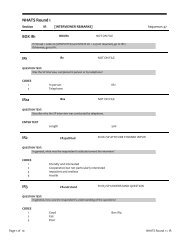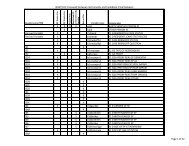Classification of Persons by Dementia Status in the ... - NHATS
Classification of Persons by Dementia Status in the ... - NHATS
Classification of Persons by Dementia Status in the ... - NHATS
Create successful ePaper yourself
Turn your PDF publications into a flip-book with our unique Google optimized e-Paper software.
except medical records a diagnosis was assigned based on cl<strong>in</strong>ical judgment that was anchored<br />
<strong>in</strong> DSM-IIIR and DSM-IV criteria. Next, <strong>the</strong> consensus panel used all data <strong>in</strong>clud<strong>in</strong>g medical<br />
records to assign a f<strong>in</strong>al research diagnosis (aga<strong>in</strong> us<strong>in</strong>g cl<strong>in</strong>ical judgment that was anchored <strong>in</strong><br />
DSM-IIIR and DSM-IV criteria). Three diagnostic classifications were developed: dementia, CIND<br />
(functional impairment that did not meet criteria for dementia or performance > 1.5 SDs below<br />
published norms on any one <strong>of</strong> multiple cognitive tests and performance was below<br />
expectation based on educational level, read<strong>in</strong>g level and occupational atta<strong>in</strong>ment) and normal.<br />
<strong>NHATS</strong> criteria were developed for <strong>the</strong> ADAMS Wave E participants as well. 3<br />
Table 6 shows sensitivity and specificity <strong>of</strong> <strong>NHATS</strong> dementia classifications if dementia is<br />
narrowly def<strong>in</strong>ed as probable dementia only, and broadly def<strong>in</strong>ed, as probable or possible<br />
dementia. Sensitivity for <strong>the</strong> narrow <strong>NHATS</strong> def<strong>in</strong>ition (proportion correctly identified among<br />
ADAMS dementia diagnosis cases) is 65.7%. Not surpris<strong>in</strong>gly, sensitivity drops considerably<br />
aga<strong>in</strong>st a diagnosis <strong>of</strong> dementia or CIND <strong>in</strong> ADAMS (43.6%). Specificity is high us<strong>in</strong>g <strong>the</strong> <strong>NHATS</strong><br />
narrow def<strong>in</strong>ition (possible or no dementia) aga<strong>in</strong>st ADAMS-based criteria for normal (87.2%) or<br />
normal plus CIND (100%).<br />
If a broader def<strong>in</strong>ition <strong>of</strong> probable or possible dementia is used, sensitivity improves—85.7%<br />
aga<strong>in</strong>st a dementia diagnosis <strong>in</strong> ADAMS, and 71.8% <strong>of</strong> those diagnosed as dementia or CIND.<br />
Table 6. Sensitivity and Specificity <strong>of</strong> <strong>NHATS</strong> criteria<br />
<strong>NHATS</strong> criteria<br />
ADAMS research diagnosis criteria<br />
<strong>Dementia</strong> (35) CIND+ Normal (86) <strong>Dementia</strong>+ CIND (78) Normal (43)<br />
Narrow<br />
def<strong>in</strong>ition:<br />
Probable 65.7% (23) 12.8%(11) 43.6% (34) ---<br />
Possible<br />
+No dementia<br />
Broad<br />
def<strong>in</strong>ition:<br />
Probable<br />
+Possible<br />
34.3% (12) 87.2% (75) 56.4% (44) 100.0% (43)<br />
85.7% (30) 38.4%(33) 71.8% (56) 16.3% (7)<br />
No dementia 14.3% (5) 61.6% (53) 28.2% (22) 83.7% (36)<br />
3 With support from David Weir PhD, PI <strong>of</strong> <strong>the</strong> HRS, and Brenda Plassman PhD, PI and study director for<br />
<strong>the</strong> ADAMS, <strong>the</strong> clock draw<strong>in</strong>g test, which is a component <strong>of</strong> <strong>the</strong> <strong>NHATS</strong> cognitive test battery was<br />
<strong>in</strong>cluded <strong>in</strong> <strong>the</strong> ADAMS Wave E data collection.<br />
DRAFT POSTED JULY 26, 2013




